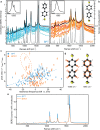Nanooptics of molecular-shunted plasmonic nanojunctions
- PMID: 25494169
- PMCID: PMC4312133
- DOI: 10.1021/nl5041786
Nanooptics of molecular-shunted plasmonic nanojunctions
Abstract
Gold nanoparticles are separated above a planar gold film by 1.1 nm thick self-assembled molecular monolayers of different conductivities. Incremental replacement of the nonconductive molecules with a chemically equivalent conductive version differing by only one atom produces a strong 50 nm blue-shift of the coupled plasmon. With modeling this gives a conductance of 0.17G(0) per biphenyl-4,4'-dithiol molecule and a total conductance across the plasmonic junction of 30G(0). Our approach provides a reliable tool quantifying the number of molecules in each plasmonic hotspot, here <200.
Keywords: Sensing; molecular conductivity; nanophotonics; plasmonic coupling; plasmonics; surface-enhanced Raman spectroscopy.
Figures



References
-
- Heeger A. J.; Kivelson S.; Schrieffer J. R.; Su W.-P. Rev. Mod. Phys. 1988, 60, 781–850. - PubMed
-
- Kelley T. W.; Baude P. F.; Gerlach C.; Ender D. E.; Muyres D.; Haase M. A.; Vogel D. E.; Theiss S. D. Chem. Mater. 2004, 16, 4413–4422.
-
- Burroughes J. H.; Bradley D. D. C.; Brown A. R.; Marks R. N.; Mackay K.; Friend R. H.; Burns P. L.; Holmes A. B. Nature 1990, 347, 539–541.
-
- Reineke S.; Lindner F.; Schwartz G.; Seidler N.; Walzer K.; Lüssem B.; Leo K. Nature 2009, 459, 234–238. - PubMed
-
- Günes S.; Neugebauer H.; Sariciftci N. S. Chem. Rev. 2007, 107, 1324–1338. - PubMed
Publication types
Grants and funding
LinkOut - more resources
Full Text Sources
Other Literature Sources

